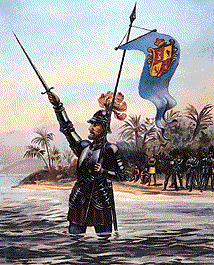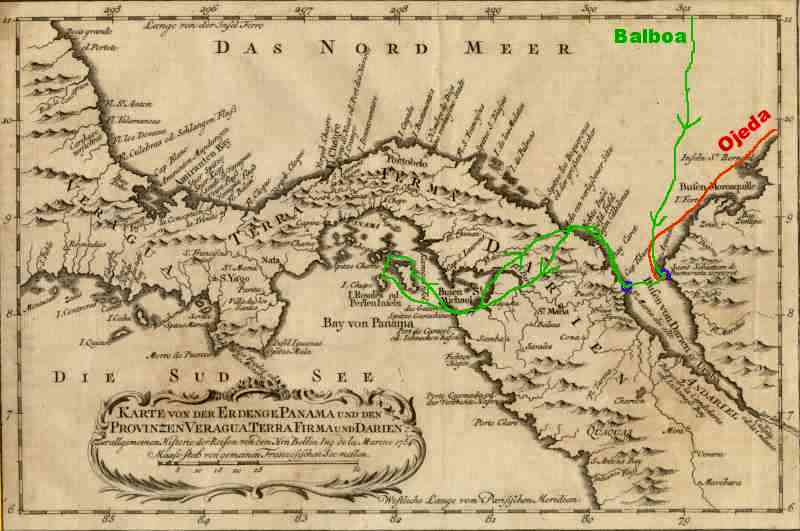|
|
|
|
|
|
|
Panciaco tells Balboa of the South Sea -- From De Bry,"India Occidentalis", 1594 |
|
|
On September 1, 1513, Balboa set of from Antigua with a force of 190 hand
picked men, including Francisco Pizarro, and about 1,000 natives and a pack of
dogs. in search of this sea. They set off by sea, landing in the country ruled
by the cacique, Careta. Leaving his brigantines and canoes there, they set out
on the 6th of September, from the north coast of Panama, on their march to the
Pacific. The trip went overland through
the very dense rainforests. On the way, he made friends with Ponca, and obtained
some gold, and information on the best routes to take. Ponca, also gave him some
good guided. The next Cacique he encountered was Porque. Porque was the ruler of
the village of Quarequá, and the enemy of Ponca. he offered some resistance,
but the Spaniards muskets, dogs and Indian allies quickly defeated the 1,000
warriors that Porque commanded. The chieftain and 600 of his warriors were
killed and the rest taken as prisoners. The found much gold on the bodies of the
dead Indians and took all the prisoners had. This all took place on the 24th of
September. At this point, all of Ponca's guides were sent home, and the
prisoners were pressed into service.
The next day, they continued their march. They soon came upon a mountain, that the guides told him, he would be able to see the ocean that he was searching for, from its summit. The next day, at 10:00 AM, he climbed to the top, alone. From there, he could see the South Sea, which made him the first European to see it. He then fell on his knees to thank God. He then signaled his men to come up. His men than rushed up the mountain, and they all prayed and thanked God. Balboa, in the prescribed form, took possession of the sea itself, and lands that lay in it, or whose shores it washed, for the crown of Castile. A notary recorded the event, and wrote down the names of all the Spaniards present. Coming down from the mountain, they proceeded towards the sea. He found that his way was blocked by a cacique named Chiapes. With the use of their muskets, dogs, and Indian allies, they quickly routed the natives. Chiapes was able to escape, but Balboa was able to convince him into being a friend. Chiapes gave Balboa a large amount of gold. On September 29, Balboa, 26 of his men, Chiapes and some Indians reached the shore. At high tide, Balboa waded into the water, with a Spanish flag, banner with the arms of Leon and Castile, and a cross. They again took everlasting possession< "until the universal judgment of all mankind" of the Mar del Sur and all the shores they touched, in he name of Don Fernando and Doña Juana, sovereigns of Castile, of Leon and Aragon. Since the date was the feast of St. Michael, he called the nearest waters,. the Golfo de San Miguel. |
|
|
|
|
|
Balboa took a heave toll of gold and pearls from Cocua and Tumaxo, two local
caciques. They told him that the land extended indefinitely to the north and
south. They also told of large cities to the South, where gold was abundant. On
October 29, he had them take him far into the Gulf of Panama, and again took
possession of it. To the island that were rich in pearls, he gave the name of
Islas de las Perlas.
On his return trip, they took another route, subduing several caciques along the way, and extracting a heavy toll in gold from them. He arrived in Antigua on January 19, 1514, with great triumph. He did not lose a single one of his men during this expedition. He had collected 40,000 pesos in gold, pearls, and large amounts of cotton cloth. After deducting the twenty percent that belonged to the Crown, the rest was divided among all the men that took part in the expedition, and to the people that stayed behind in Antigua. Some of the booty was also set aside for special occasion, of the town. This was in hope of legitimizing himself in the eyes of the Crown, Balboa had a letter written on March 4, 1514, to the King, telling of his exploits and conquests. He sent all the gold and pearls that was his share, along with an additional 250 pounds of the finest pearls as a gift to the King |
|
|
|




 This map depicts an approximate route for Balboa. The exact
path he took, is unknown and very much debated by historians. Map from:
Karte von de Erdenge Panama - Cartographer: Hrn. Bellin, Ing. 1754.
This map depicts an approximate route for Balboa. The exact
path he took, is unknown and very much debated by historians. Map from:
Karte von de Erdenge Panama - Cartographer: Hrn. Bellin, Ing. 1754.